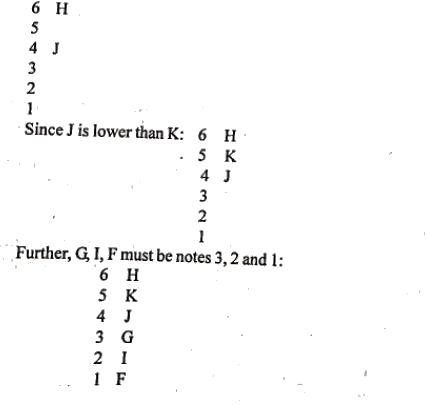A certain musical scale consists of exactly six notes: F, G, H, I, J and K. The notes are arranged from the lowest (the first note of the scale) to the highest (the sixth note of the scale). Each note appears once and only once in the scale, and the intervals between the notes are all equal.
i) J is lower than K.
ii) G is higher than F.
I is somewhere between F and G.
H is the highest note of scale.
If J is the fourth note of the scale , which of the following must be true ?
F is the fifth note.
G is the second note.
I is the fourth note.
I is the second note.
The correct Answer is:D
Begin by summarising the information:
(G is higher than F F is lower than G.)
F-I-G or G-I-F
H=6
There is one further conclusion you should probably note. Since G is higher than F, and since I is between F and G, the order for those three notes is :
Enter the additional information on a diagram :

Topper's Solved these Questions
- PROBLEM SOLVINGBOOK - M K PANDEYCHAPTER - PROBLEM SOLVINGEXERCISE - (EXERCISE 20 C)
147 Videos
- PROBLEM SOLVINGBOOK - M K PANDEYCHAPTER - PROBLEM SOLVINGEXERCISE - (EXERCISE 20 A)
34 Videos
- INPUT-OUTPUT(..CONTD):ARRANAGEMENTBOOK - M K PANDEYCHAPTER - INPUT-OUTPUT(..CONTD):ARRANAGEMENTEXERCISE - PRACTICE EXERCISE
41 Videos
- SYLLOGISMBOOK - M K PANDEYCHAPTER - SYLLOGISMEXERCISE - PRACTICE EXERCISES (TYPE III: EXERCISE 11 C)
25 Videos
Similar Questions
Knowledge Check
A certain musical scale consists of exactly six notes: F, G, H, I, J and K. The notes are arranged from the lowest (the first note of the scale) to the highest (the sixth note of the scale). Each note appears once and only once in the scale, and the intervals between the notes are all equal.
i) J is lower than K.
ii) G is higher than F.
I is somewhere between F and G.
H is the highest note of scale.
If exactly two notes separate F and I, then which of the following must be true ?AF is the lowest note.BK is the fifth noteCK is higher than I.DK and J are separated by exactly one note.A certain musical scale consists of exactly six notes: F, G, H, I, J and K. The notes are arranged from the lowest (the first note of the scale) to the highest (the sixth note of the scale). Each note appears once and only once in the scale, and the intervals between the notes are all equal.
i) J is lower than K.
ii) G is higher than F.
I is somewhere between F and G.
H is the highest note of scale.
Which of the following CANNOT be true of the scale ?AG is the second note.BG is the third note.CI is somewhere between F and G.DH is the highest note of scale.A certain musical scale consists of exactly six notes: F, G, H, I, J and K. The notes are arranged from the lowest (the first note of the scale) to the highest (the sixth note of the scale). Each note appears once and only once in the scale, and the intervals between the notes are all equal.
i) J is lower than K.
ii) G is higher than F.
I is somewhere between F and G.
H is the highest note of scale.
If J is the second note, then G and I could be which of the following respectively ?
I. 4 and 3
II. 5 and 3
III. 5 and 4AI onlyBIII onlyCII and III onlyDI, II and III
What is a note ?
View SolutionWrite notes on the following
(i) Baculoviruses
View SolutionA certain musical scale consists of exactly six notes: F, G, H, I, J and K. The notes are arranged from the lowest (the first note of the scale) to the highest (the sixth note of the scale). Each note appears once and only once in the scale, and the intervals between the notes are all equal.
i) J is lower than K.
ii) G is higher than F.
I is somewhere between F and G.
H is the highest note of scale.
If F and I are separated by exactly one note, which of the following must be true ?
View SolutionQuality of a musical note depends on
View SolutionIn a harmonium the intermediate notes between a note and its octave form
View Solution
